Even though the tambourine is one of the easiest instruments to play, it is an extremely versatile percussion instrument. It offers various sounds and many techniques. This tutorial will explore playing the tambourine and practising different methods, making it perfect for beginners and professional musicians.
Choosing the Right Tambourine
There are many tambourines, but the method of playing them is the same. We will focus on two kinds: one with a round frame and another with a crescent or moon shape. Both tambourines can produce rich sounds, but the frame shape influences the overall feel of the instrument.
Holding the Tambourine
I recommend starting with a steady and straightforward technique when teaching beginners or younger students. Hold the tambourine in what we call the "holding hand." This means one hand stays steady, supporting the tambourine while the other plays it. This is the easiest way to get started because it frees up one hand, helping beginners focus solely on playing.
For example, if you're right-handed, hold the tambourine in your left hand and play it with your right hand. The playing position should be around the waist level or slightly higher. This setup ensures stability and gives you better control over the sound you produce.
Basic Playing Technique
To play the tambourine, hold it securely and tap the outer edge with your fingers or palm. The angle at which you have the tambourine is the key to achieving a great sound. When held upright, the jingles produce a sustained, loose sound. Tilting it creates a tighter, drier tone. Experiment with different angles, particularly between 1 and 3 o'clock, to discover the sound that suits you best. A slight tilt often provides the most controlled and pleasing sound, so take the time to find your ideal position.
Advanced Techniques
Once you're comfortable with the basic tapping, you can move on to more advanced techniques. The first is the "pop tambourine" technique, which is common in pop music. In this technique, you move the tambourine while striking it on your palm, which remains stationary.
Hold the tambourine sideways and swing it back and forth to perform the pop tambourine style. Strike it softly on your palm to produce a clean, controlled sound. This technique requires careful coordination between the striking hand and the palm, ensuring that the tambourine remains steady in your grasp while you create the rhythm.
Gospel Technique
Next, you will learn the gospel technique, an advanced technique in which the tambourine is rotated while struck. Hold the tambourine in one hand and rotate it whilst hitting the jingles. This motion adds an extra layer of complexity and produces a unique textured sound.
You can experiment with different types of tambourines, as each will have a different tone based on the size of the instrument and the material used. Some tambourines have nickel-plated jingles, while others may feature bronze or brass jingles. The quality of the jingles will affect the sound, so don't be afraid to try different instruments to find the one that suits your style.
Putting It All Together
After learning the basics and advanced techniques, you will want to practice because mastery comes from repetition. Incorporate music tracks into your practice routine to develop your timing and rhythmic skills. Once you feel confident with basic techniques, you can experiment with advanced rhythm techniques like sideways movements and up-tempo accents.
For those interested in using tambourines with drum heads, like those used in commercial or pop music styles, the methods are similar but often incorporate more dynamic movement. The heads on these tambourines help create a richer, drum-like sound. Keep it simple and musical as you practice, and soon, you can incorporate complex rhythms and accents into your playing.












